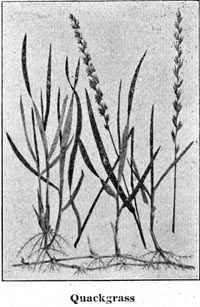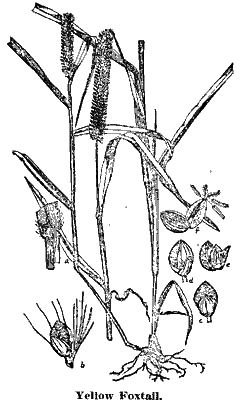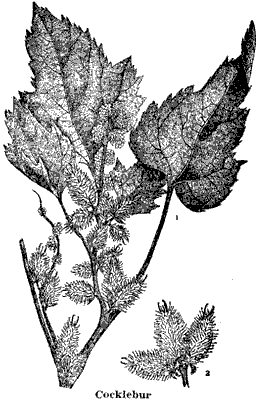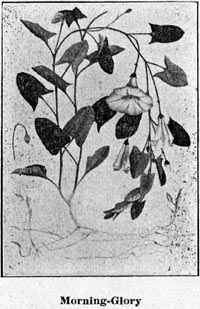(Genus-Agropyrum)

NEGenWeb
Project
Resource Center
Schools
|
232 |
|
This perennial weed is especially troublesome in low, wet places and is very hard to destroy. It grows from one to three feet in height. The flowers which appear during July and August resemble those of the heart's-ease. The leaves are much the same shape as those of the heart's-ease, although they are somewhat larger and much more numerous. The plant grows from seeds which ripen during August and September and from large, heavy, woody rootstocks that make ground containing the pest especially hard to plow. Turning the rootstocks to the sun by deep plowing is effective as well as other methods employed in destroying perennials mentioned in the fore part of this bulletin.
(Genus-Polygonum)
This plant is an annual, growing from one to two and one-half feet high. The leaves are rather long and narrow, with a distinctly bitter taste. The flowers are usually of a pink color and appear during July and August. The seeds ripen during August and September. This weed is most commonly found on low ground in cornfields. It is also often seen along fence lines and hog lots, where it is not eaten because of its bitter, acid taste. It can be eradicated by thorough cultivation and the prevention of seeding.
|
|
233 |
(Genus-Panicum)
This weed does its greatest damage to hoed crops in low wet places. It is also commonly found along fence lines, in waste places, etc. Barnyard grass is an annual of heavy foliage growing from one to three feet high. The leaves are wide, with a very heavy midrib. Its green flowers appear from June to August. The seeds ripen from July to September. The seeds are produced on rather a loose spike resembling somewhat German millet. Thorough cultivation and preventing the formation of seeds will destroy this pest.
(Genus-Panicum)
Crab grass is an annual commonly found in lawns and in some cases troublesome in cornfields. It varies in height from six inches to three feet and spreads on the ground. It frequently takes root where the joints come in contact with the earth, making it rather hard to eradicate. The seeds are produced on spikes, hence the name "Finger grass." Thorough cultivation and continual mowing to prevent seeding will destroy crab grass.
(Genus-Agropyrum)

|
234 |
|
Quack grass has been a troublesome perennial weed in certain sections east of the Missouri river for many years, but it is only recently that it has become well established in Nebraska. Quack grass is of little value as hay, for the leaves are too rough to be palatable and the growth is so sparse that very little is produced on an acre. When the plant is young it greatly resembles timothy. When it becomes older the leaves become narrow, somewhat light in color, and rough on the edges. It grows to a height varying from sixteen to twenty-four inches. The seeds are borne on a stem which is bare at

the base. The arrangement of the seeds is similar to perennial rye grass. This weed is also propagated by underground stems which send up sprouts at irregular intervals. Owing to the ease with which the routs start to grow, it is an especially hard weed to eradicate. Pieces of roots catch in the plow, harrow, cultivator, or other machinery and scatter the pest over great areas. It seems that any part of the root, no matter how small, which is broken off and carried to another place will start to grow.
|
|
235 |
The most practical method of combating quack grass depends much on the area infested. Where only found in spots, digging up and removing the roots will be found the most effective method of destruction. In case an acre or more is infested, the use of smother crops described in the fore part of this bulletin is more practical.
(Genus-Setaria)
These weeds are annuals. The two kinds of foxtails commonly found In our cornfields are yellow and green. However, the same general method of eradication applies to each. They grow from one to two feet high, with leaves about five or six inches long. The seeds are borne at the end of spikes and somewhat resemble millet. These weeds are so well known that a detailed description is not necessary. It is estimated that one plant will produce about three thousand seeds. These seeds retain their vitality for a long time. Clean cultivation and not allowing the plants to bear seeds are the best known remedies of eradication.
(Genus-Xanthium)

|
236 |
|
The cocklebur Is an annual so well known that a description seems useless. It is commonly found on low and flood ground. Each bur contains two flowers which later produce seeds. One of these seeds germinates the first spring while the other usually does not start to grow until some later season; however, both seeds have been known to produce plants the same year. The cocklebur not only damages the growing crop, but because of the indigestibility, of the husks and the barbs with which they are protected, it is especially Injurious to stock. The burs are scattered from one field to another by water, also by rabbits, dogs, and other animals. Stock transferred from one farm to another should be examined carefully and all burs removed.
Pulling all plants before seeding, year after year until all the seeds in the ground have germinated, is practically the only successful method of destroying cockleburs. This usually takes three or four years. Seeding to grass and pasturing close with hogs has also proved effective. However, if the plants become large the hogs will refuse to eat them.
(Genus-Convolulus)

The most troublesome morning-glories are the deep-rooted perennial kinds with many fleshy rootstocks which send up shoots at irregular intervals. These twine themselves around any plant growing within reach, using them for supports and smothering them out. The
 |
 |
 |
 |
|
© 2003 for the NEGenWeb Project by Ted & Carole Miller |
|||